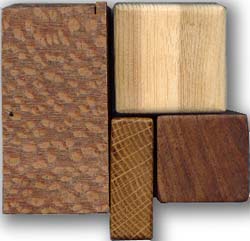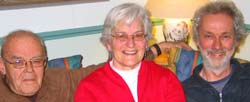
Top: Leopard Wood from Australia (but this
specimen was grown in South America), Tamarack, used
in railway ties, from Larder Lake, Ontario
Bottom: White Oak - notice
the medulary rays radiating across the grain - Canada, and Black
Walnut from Stratford, Ontario.
|
Pocket-sized Stromatolite
He brought me a small fossil of a stromatolite - a layered,
cabbage-like structure created by marine micro-organisms such as bacteria
and algae - from a Canadian rock formation. When I think of stromatolites
I picture the lagoon in Shark Bay, Australia, where they are the size
of coffee tables – they can be the size of a small hill, Richard
tells me – but in the fossil he gave me they are no larger than
button mushrooms.
Oak, Pine and Walnut
He’s kept his interest in timber and, along with the fossil, he
gave me these polished off-cuts. He tells me our doors are Monterey
Pine – a fast-growing species, as you can tell by the well-spaced
growth rings. It’s often planted and it makes good timber as it’s
so stable.
What's Cooking?
He can identify many timbers by smell alone – different species
have a characteristic smells and, to my surprise, when we were in the
garden he was able to identify one of our herbs by smell alone from 3
yards away.
“Is someone cooking a curry?” he asked.
It was our curry plant. I could smell it when I rubbed
the leaves in my fingers but I wouldn’t have picked up the spicy
fragrance from that distance. And, unlike Richard, I’ve never smoked.
|

